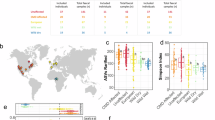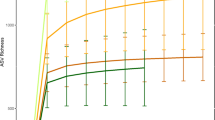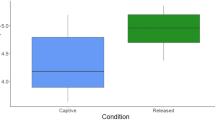Abstract
Although the critical role that our gastrointestinal microbes play in host physiology is now well established, we know little about the factors that influenced the evolution of primate gut microbiomes. To further understand current gut microbiome configurations and diet–microbe co-metabolic fingerprints in primates, from an evolutionary perspective, we characterized fecal bacterial communities and metabolomic profiles in 228 fecal samples of lowland and mountain gorillas (G. g. gorilla and G. b. beringei, respectively), our closest evolutionary relatives after chimpanzees. Our results demonstrate that the gut microbiomes and metabolomes of these two species exhibit significantly different patterns. This is supported by increased abundance of metabolites and bacterial taxa associated with fiber metabolism in mountain gorillas, and enrichment of markers associated with simple sugar, lipid and sterol turnover in the lowland species. However, longitudinal sampling shows that both species’ microbiomes and metabolomes converge when hosts face similar dietary constraints, associated with low fruit availability in their habitats. By showing differences and convergence of diet–microbe co-metabolic fingerprints in two geographically isolated primate species, under specific dietary stimuli, we suggest that dietary constraints triggered during their adaptive radiation were potential factors behind the species-specific microbiome patterns observed in primates today.
Similar content being viewed by others
Log in or create a free account to read this content
Gain free access to this article, as well as selected content from this journal and more on nature.com
or
Change history
19 January 2016
This paper was modified 12 months after initial publication to switch to Creative Commons licence terms, as noted at publication
References
Amato KR, Leigh SR, Kent A, Mackie RI, Yeoman CJ, Stumpf RM et al. (2014a). The gut microbiota appears to compensate for seasonal diet variation in the wild Black Howler Monkey (Alouatta pigra). Microb Ecol 69: 434–443.
Amato KR, Leigh SR, Kent A, Mackie RI, Yeoman CJ, Stumpf RM et al. (2014b). The role of gut microbes in satisfying the nutritional demands of adult and juvenile wild, black howler monkeys (Alouatta pigra). Am J Phys Anthropol 155: 652–664.
Barks SK, Calhoun ME, Hopkins WD, Cranfield MR, Mudakikwa A, Stoinski TS et al. (2015). Brain organization of gorillas reflects species differences in ecology. Am J Phys Anthropol 156: 252–262.
Behrensmeyer AK . (2006). Climate change and human evolution. Science(Washington) 311: 476–478.
Chapman C, Rothman J, Lambert J . (2012) Food as a selective force in primates. The evolution of primate societies. University Of Chicago Press: Chicago, pp 149–168.
Chung K . (1997) Gastrointestinal Toxicology of Monogastrics. Mackie R, White B (eds).Gastrointestinal Microbiology. Heidelberg: Springer, 511–582.
Clarke K . (1993). Nonparametric multivariate analyses of changes in community structure. Aust J Ecol 18: 117–143.
Collins A, Dubach J . (2000). Biogeographic and ecological forces responsible for speciation in Ateles. Int J Primatol 21: 421–444.
Cordain L, Eaton SB, Sebastian A, Mann N, Lindeberg S, Watkins BA et al. (2005). Origins and evolution of the Western diet: health implications for the 21st century. Am J Clin Nutr 81: 341–354.
Core Team R . (2014) R Core Team (2014). R: A language and environment for statistical computing. R Foundation for Statistical Computing, Vienna: Austria. Available from: http://www.R-project.org/.
David LA, Maurice CF, Carmody RN, Gootenberg DB, Button JE, Wolfe BE et al. (2014). Diet rapidly and reproducibly alters the human gut microbiome. Nature 505: 559–563.
Doran D, McNeilage A . (1998). Gorilla ecology and behavior. Evol Anthropol 6: 120–131.
Doran-Sheehy D, Boesch C . (2004). Behavioral ecology of western gorillas: New insights from the field. Am J Primatol 64: 139–143.
Dufrene M, Legendre P . (1997). Species assemblages and indicator species: The need for a flexible asymmetrical approach. Ecol Monogr 67: 345–366.
Flint HJ, Bayer EA . (2008). Plant cell wall breakdown by anaerobic microorganisms from the mammalian digestive tract. Ann N Y Acad Sci 1125: 280–288.
Flint HJ, Bayer EA, Rincon MT, Lamed R, White BA . (2008). Polysaccharide utilization by gut bacteria: potential for new insights from genomic analysis. Nat Rev Microbiol 6: 121–131.
Ganas J, Robbins MM, Nkurunungi JB, Kaplin BA, McNeilage A . (2004). Dietary variability of mountain gorillas in Bwindi Impenetrable National Park, Uganda. Int J Primatol 25: 1043–1072.
Garner CE, Smith S, de Lacy Costello B, White P, Spencer R, CSJ Probert et al. (2007). Volatile organic compounds from feces and their potential for diagnosis of gastrointestinal disease. FASEB J 21: 1675–1688.
Gerard P . (2010) Gastrointestinal Tract: Microbial Metabolism of Steroids In: Springer: Berlin, Heidelberg, pp 3133–3140.
Giraudoux P . (2014), pgirmess: Data Analysis in Ecology http://CRAN.R-project.org/package=gplots R package version 1.5.9.
Gomez A, Petrzelkova K, Yeoman CJ, Vlckova K, Mrázek J, Koppova I et al. (2015). Gut microbiome composition and metabolomic profiles of wild western lowland gorillas (Gorilla gorilla gorilla) reflect host ecology. Mol Ecol 24: 2551–2565.
Gomez JM, Verdu M . (2012). Mutualism with plants drives primate diversification. Syst Biol 61: 567–577.
Henry AG, Brooks AS, Piperno DR . (2011). Microfossils in calculus demonstrate consumption of plants and cooked foods in Neanderthal diets (Shanidar III, Iraq; Spy I and II, Belgium). Proc Natl Acad Sci USA 108: 486–491.
Horrobin DF . (1999). Lipid metabolism, human evolution and schizophrenia. Prostaglandins Leukot Essent Fatty Acids 60: 431–437.
Indahl UG, Liland KH, Næs T . (2009). Canonical partial least squares-a unified PLS approach to classification and regression problems. J Chemometrics 23: 495–504.
Jones BV, Begley M, Hill C, Gahan CGM, Marchesi JR . (2008). Functional and comparative metagenomic analysis of bile salt hydrolase activity in the human gut microbiome. Proc Natl Acad Sci USA 105: 13580–13585.
Knott C . (1998). Changes in orangutan caloric intake, energy balance, and ketones in response to fluctuating fruit availability. Int J Primatol 19: 1061–1079.
Ley RE, Hamady M, Lozupone C, Turnbaugh PJ, Ramey RR, Bircher JS et al. (2008). Evolution of mammals and their gut microbes. Science 320: 1647–1651.
Lin A, Bik EM, Costello EK, Dethlefsen L, Haque R, Relman DA et al. (2013). Distinct distal gut microbiome diversity and composition in healthy children from Bangladesh and the United States. PloS one 8: e53838.
Martin FJ, Dumas M, Wang Y, Legido‐Quigley C, IKS Yap, Tang H et al. (2007). A top‐down systems biology view of microbiome‐mammalian metabolic interactions in a mouse model. Mol Sys Biol 3: 112.
Masi S, Chauffour S, Bain O, Todd A, Guillot J, Krief S . (2012). Seasonal effects on great ape health: a case study of wild chimpanzees and Western gorillas. PLoS One 7: e49805.
Masi S, Cipolletta C, Robbins MM . (2009). Western lowland gorillas (Gorilla gorilla gorilla) change their activity patterns in response to frugivory. Am J Primatol 71: 91–100.
Masi S . (2007)., Seasonal influence on foraging [strategies], activity and energy budgets of Western Lowland gorillas (gorilla gorilla gorilla) in Bai-Hokou, Central African Republic. Ph.D. Thesis. Italy: University of Rome "La Sapienza"..
McGrew WC . (2007). Savanna chimpanzees dig for food. Proc Natl Acad Sci USA 104: 19167–19168.
Milton K . (1993). Diet and primate evolution. Sci Am 269: 86–93.
Moco S, Martin FJ, Rezzi S . (2012). Metabolomics view on gut microbiome modulation by polyphenol-rich foods. J Proteome Res 11: 4781–4790.
Moeller A, Peeters M, Ndjango J, Li Y, Hahn B, Ochman H . (2013). Sympatric chimpanzees and gorillas harbor convergent gut microbial communities. Genome Res 23: 1715–1720.
Muegge BD, Kuczynski J, Knights D, Clemente JC, Gonzalez A, Fontana L et al. (2011). Diet drives convergence in gut microbiome functions across mammalian phylogeny and within humans. Science 332: 970–974.
Navarrete A, van Schaik CP, Isler K . (2011). Energetics and the evolution of human brain size. Nature 480: 91–93.
Nenadic O, Greenacre M . (2007). Correspondence analysis in R, with two- and three-dimensional graphics: The ca package. J Stat Software 20.
Obregon-Tito A, Tito RY, Metcalf J, Sankaranarayanan K, Clemente JC, Ursell LK et al. (2015). Subsistence strategies in traditional societies distinguish gut microbiomes. Nat Commun 6: 6505.
Ochman H, Worobey M, Kuo CH, Ndjango JB, Peeters M, Hahn BH et al. (2010). Evolutionary relationships of wild hominids recapitulated by gut microbial communities. PLoS Biol 8: e1000546.
Oksanen J, Guillaume Blanchet F, Kindt R, Legendre P, Minchin PR, O'Hara RB et al. (2012), vegan: Community Ecology Package http://CRAN.R-project.org/package=vegan R package version 2.0-5.
Pena MJ, Ryden P, Madson M, Smith AC, Carpita NC . (2004). The galactose residues of xyloglucan are essential to maintain mechanical strength of the primary cell walls in Arabidopsis during growth. Plant Physiol 134: 443–451.
Pérez‐Pantoja D, Donoso R, Agulló L, Córdova M, Seeger M, Pieper DH et al. (2012). Genomic analysis of the potential for aromatic compounds biodegradation in Burkholderiales. Environ Microbiol 14: 1091–1117.
Pope PB, Smith W, Denman SE, Tringe SG, Barry K, Hugenholtz P et al. (2011). Isolation of Succinivibrionaceae Implicated in Low Methane Emissions from Tammar Wallabies. Science 333: 646–648.
Reiner WB, Petzinger C, Power ML, Hyeroba D, Rothman JM . (2014). Fatty acids in mountain gorilla diets: implications for primate nutrition and health. Am J Primatol 76: 281–288.
Remis MJ . (1997a). Ranging and grouping patterns of a western lowland gorilla group at Bai Hokou, Central African Republic. Am J Primatol 43: 111–133.
Remis MJ . (1997b). Western lowland gorillas (Gorilla gorilla gorilla) as seasonal frugivores: Use of variable resources. Am J Primatol 43: 87–109.
Remis M, Dierenfeld E, Mowry C, Carroll R . (2001). Nutritional aspects of western lowland gorilla (Gorilla gorilla gorilla) diet during seasons of fruit scarcity at Bai Hokou, Central African Republic. Int J Primatol 22: 807–836.
Remis M . (1997c). Western lowland gorillas (Gorilla gorilla gorilla) as seasonal frugivores: Use of variable resources. Am J Primatol 43: 87–109.
Revelle W . (2014). psych: Procedures for Psychological, Psychometric, and Personality Research. R package version 1.4.5.
Robbins MM . (2011) Gorillas: diversity in ecology and behavior. In: Primates in Perspective. Oxford University Press: : New York, US, pp 326–339.
Roberts DW . (2012). labsdv: Ordination and Multivariate Analysis for Ecology. Available from: http://ecology.msu.montana.edu/labdsv/R.
Rogers ME, Abernethy K, Bermejo M, Cipolletta C, Doran D, McFarland K et al. (2004). Western gorilla diet: a synthesis from six sites. Am J Primatol 64: 173–192.
Rogers M, Maisels F, Williamson E, Fernandez M, Tutin C . (1990). Gorilla Diet in the Lope Reserve, Gabon - a Nutritional Analysis. Oecologia 84: 326–339.
Rothman JM, Nkurunungi JB, Shannon BF, Bryer MA . (2014). High altitude diets: implications for the feeding and nutritional ecology of mountain gorillas. High Altitude Primates. Springer: New York, NY, USA, pp 247–264.
Rothman JM, Pell AN, Nkurunungi JB, Dierenfeld ES . (2006) Nutritional aspects of the diet of wild gorillas Primates of Western Uganda. Springer: New York, NY, USA, pp 153–169.
Rothman JM, Raubenheimer D, Chapman CA . (2011). Nutritional geometry: gorillas prioritize non-protein energy while consuming surplus protein. Biol Lett 7: 847–849.
Rothman JM, Dierenfeld ES, Hintz HF, Pell AN . (2008). Nutritional quality of gorilla diets: consequences of age, sex, and season. Oecologia 155: 111–122.
Rothman JM, Plumptre AJ, Dierenfeld ES, Pell AN . (2007). Nutritional composition of the diet of the gorilla (Gorilla beringei): a comparison between two montane habitats. J Trop Ecol 23: 673–682.
Rothman J, Chapman C, Soest P . (2012). Methods in Primate Nutritional Ecology: A Userâ•™s Guide. Int J Primatol 33: 542–566.
Sanders JG, Powell S, Kronauer DJC, Vasconcelos HL, Frederickson ME, Pierce NE . (2014). Stability and phylogenetic correlation in gut microbiota: lessons from ants and apes. Mol Ecol 23: 1268–1283.
Scally A, Dutheil JY, Hillier LW, Jordan GE, Goodhead I, Herrero J et al. (2012). Insights into hominid evolution from the gorilla genome sequence RID D-2982-2009. Nature 483: 169–175.
Schloss PD, Gevers D, Westcott SL . (2011). Reducing the effects of PCR amplification and sequencing artifacts on 16 S rRNA-based studies. PLoS ONE 6: e27310.
Schnorr SL, Candela M, Rampelli S, Centanni M, Consolandi C, Basaglia G et al. (2014). Gut microbiome of the Hadza hunter-gatherers. Nat Commun 5: 3654.
Shannon P, Markiel A, Ozier O, Baliga NS, Wang JT, Ramage D et al. (2003). Cytoscape: A Software Environment for Integrated Models of Biomolecular Interaction Networks. Genome Res 13: 2498–2504.
Stanford CB, Nkurunungi JB . (2003). Behavioral ecology of sympatric chimpanzees and gorillas in Bwindi Impenetrable National Park. Int J Primatol 24: 901–918.
Sussman RW . (1991). Primate origins and the evolution of angiosperms. Am J Primatol 23: 209–223.
Turnbaugh PJ, Hamady M, Yatsunenko T, Cantarel BL, Duncan A, Ley RE et al. (2009). A core gut microbiome in obese and lean twins. Nature 457: 480–484.
Watts DP . (1984). Composition and variability of mountain gorilla diets in the Central Virungas. Am J Primatol 7: 323–356.
Wu GD, Chen J, Hoffmann C, Bittinger K, Chen Y, Keilbaugh SA et al. (2011). Linking long-term dietary patterns with gut microbial enterotypes. Science 333: 105–108.
Xia J, Psychogios N, Young N, Wishart DS . (2009). MetaboAnalyst: a web server for metabolomic data analysis and interpretation. Nucleic Acids Res 37: W652–W660.
Yatsunenko T, Rey FE, Manary MJ, Trehan I, Dominguez-Bello MG, Contreras M et al. (2012). Human gut microbiome viewed across age and geography. Nature 486: 222–227.
Yildirim S, Yeoman CJ, Sipos M, Torralba M, Wilson BA, Goldberg TL et al. (2010). Characterization of the fecal microbiome from non-human wild primates reveals species specific microbial communities. PLoS One 5: e13963.
Acknowledgements
We thank the government of the Central African Republic, namely the Ministre de l’Education Nationale, de l’Alphabetisation, de l’Enseignement Superieur, et de la Recherche for providing research permits to conduct our work in the Central African Republic; World Wildlife Fund and the administration of DSPA for granting research approval and for assistance with obtaining permits; and the Primate Habituation Programme for providing logistical support in the field. We especially thank Dr Paul Garber (University of Illinois) and two anonymous reviewers for very important comments on this manuscript. Finally, we thank all of our field assistants and trackers for their help in the field. This work was supported by a Grant Agency of the Czech Republic (number 206/09/0927), NSF grant 0935347 and COLCIENCIAS (Colombian Agency for Science and Technology) and its doctoral fellowship program. This publication derives from the HPL-lab, Laboratory for Infectious Diseases Common to Humans and (non-Human) Primates, Czech Republic. This study was supported by the project ‘CEITEC- Central European Institute of Technology’ (CZ.1.05/1.100/02.0068) from European Regional Development Fund and further co-financed from European Social Fund and state budget of the Czech Republic (project OPVK CZ.1.07/2.3.00/20.0300). The research in Bwindi was supported by Hunter College. We thank Hillary Musinguzi and the park rangers of Bwindi for assisting with sample collection, and Pontious Ezuma, Chemonges Amusa and Simplicious Gessa for logistical support. The Uganda Wildlife Authority and the Uganda National Council for Science and Technology gave JMR permission to conduct this research.
Author information
Authors and Affiliations
Corresponding author
Ethics declarations
Competing interests
The authors declare no conflict of interest.
Additional information
Supplementary Information accompanies this paper on The ISME Journal website
Rights and permissions
About this article
Cite this article
Gomez, A., Rothman, J., Petrzelkova, K. et al. Temporal variation selects for diet–microbe co-metabolic traits in the gut of Gorilla spp. ISME J 10, 514–526 (2016). https://doi.org/10.1038/ismej.2015.146
Received:
Revised:
Accepted:
Published:
Issue date:
DOI: https://doi.org/10.1038/ismej.2015.146
This article is cited by
-
Metagenome and metabolome insights into the energy compensation and exogenous toxin degradation of gut microbiota in high-altitude rhesus macaques (Macaca mulatta)
npj Biofilms and Microbiomes (2023)
-
Seasonal responses and host uniqueness of gut microbiome of Japanese macaques in lowland Yakushima
Animal Microbiome (2022)
-
The primate gut mycobiome-bacteriome interface is impacted by environmental and subsistence factors
npj Biofilms and Microbiomes (2022)
-
The genetic impact of an Ebola outbreak on a wild gorilla population
BMC Genomics (2021)
-
Seasonal shifts in the gut microbiome indicate plastic responses to diet in wild geladas
Microbiome (2021)



